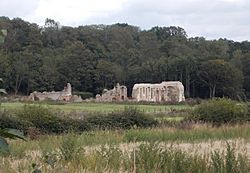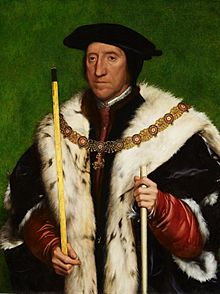Sibton Abbey facts for kids
Sibton Abbey was an old Cistercian abbey located near Yoxford, Suffolk, in England. It was started around 1150 by William de Chesney, who was a powerful local official called the High Sheriff of Norfolk and Suffolk. Sibton Abbey was like a "sister house" to Warden Abbey in Bedfordshire. It was special because it was the only Cistercian abbey in the East Anglia area. The abbey was closed down in 1536.
Contents
How Sibton Abbey Began
There's an old story about how Sibton Abbey was founded. It says that a man named Walter de Cadomo came to England with William the Conqueror. Walter owned a lot of land in a place called Horsford.
Walter's son, Robert fitz Walter, built a church in Sibton around the time of King William Rufus. Robert had three sons: Roger, John, and William.
When Robert died, his son John inherited the Horsford lands. John became very sick. He felt bad about things he had done and wanted to build a Cistercian abbey to make up for them. Knowing he didn't have much time left, he made his brother William promise to finish building the abbey.
After John died, William de Chesney (also known as William de Cayneto) took over the lands. He remembered his promise to his brother. So, he founded the Abbey of St Mary of Sibton. He gave his lands in Sibton to the abbey and signed a special paper in 1149 to make it official.
Life at the Medieval Abbey
Sibton Abbey was dedicated to the Blessed Virgin Mary. It started with 13 monks. But by the 1200s, the number of monks and lay brothers (people who helped with daily tasks) grew. The Abbey became very rich. It owned land all over southeast England. This included 12 smaller farms called granges in Norfolk, Suffolk, and near Cambridgeshire. They also owned property in 10 parts of the city of Norwich.
From the early 1200s, the Abbey also had a hospital near its gate. It was called St. John the Baptist and cared for sick people.
Abbey Buildings and Style
The buildings at Sibton Abbey followed the simple Cistercian style. But they still had some decorations. The main ruins you can see today are from the Frater, which was the dining hall for the monks. These parts were built in the mid-1100s, in the late Norman or Romanesque style.
The main church was on the north side of the cloister (an open courtyard). On the east side was the building with the dormitory (where the monks slept) and its undercroft (a room below).
Sibton is a bit unusual for a Cistercian abbey. The Frater (the ruined dining hall) made up most of the south side of the cloister. It ran from east to west. The kitchen was at the west end, and the high table for the monks was at the east end. You can still see a large, blank arch in the east wall. Usually, the dining hall would stick out at a right angle from the south side.
On the west side of the cloister, there was a wall. Beyond this wall was another building called the Cellarium. This area might have been for the lay brethren, who were separate from the monks in holy orders.
How the Abbey Grew Rich
Sibton Abbey became wealthy from farming and raising animals. They also made a lot of money from the wool trade. Many grand English churches were built because of the wool trade. Even though Suffolk wool wasn't always the best quality, it was still very popular. People in East Anglia, especially Flemish weavers, wanted it to make cloth to sell.
The abbey also had many mills. In the 1200s, they had at least 15 mills on their lands in Suffolk. These were both watermills and windmills. They used these mills to grind grain.
A scholar named Henry of Kirkestede saw a copy of a book called the Chronicon from Sibton in the 1300s. Also, a special portable sundial from the 1400s was found near the Abbey in 1989. It is now in the National Maritime Museum.
The Abbey Closes Down
During the time of the Dissolution of the Monasteries, Sibton Abbey had a yearly income of about £250. This was a lot of money! It should have meant the Abbey could stay open longer.
However, the new Abbot (the head monk) named William Flatbury was chosen because the Duke of Norfolk wanted him there. It seems the Duke and a powerful politician named Thomas Cromwell convinced Abbot Flatbury to close the Abbey quickly. Some people at the time believed that Cromwell helped Flatbury become Abbot just so he would agree to close the Abbey.
In 1536, the Abbot and the monks officially handed over the Abbey and all its property. They gave it to Thomas Howard, 3rd Duke of Norfolk, and two other men. The Duke later sold the Abbey to Thomas Godsalve, who then sold it to Thomas Howard, 1st Earl of Suffolk.
After the Abbey Closed
In 1610, the Abbey and its lands were sold to John Scrivener. His family became very rich from the wool trade. They built a large estate nearby. John Scrivener's brother, Matthew, was an early leader in the Virginia Colony in America. John's sister, Elizabeth, married into another important family.
After the Abbey closed, the building was used for other things. You can still see holes in the great archway of the dining hall. These holes were made to hold an upper floor or balcony. This was probably added when the building was changed for everyday uses.
Sibton Abbey Today
Today, Sibton Abbey is a beautiful ruin. Much of it is covered in plants. You can still see the dining hall and the south wall of the church. These parts have been repaired to keep them from falling down.
The Abbey and its lands are still owned by the Scrivener family's descendants, now called the Levett-Scrivener family. Because it's private property, you cannot visit the ruins.
In the past, the Levett-Scrivener family sometimes let history groups and historians visit the ruins. The Abbey ruins are a scheduled monument, which means they are protected by law because of their historical importance.





